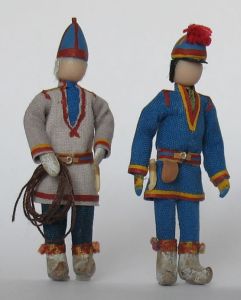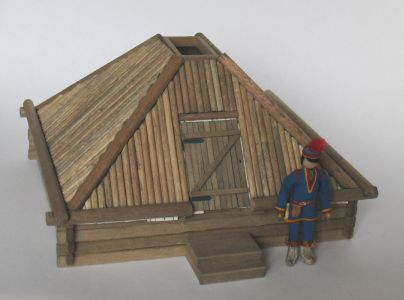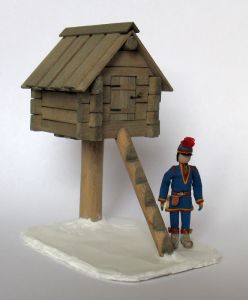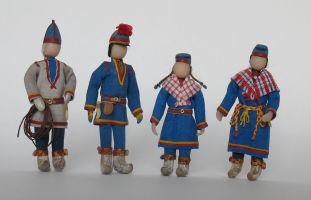
1:48 Saami
The Saami are native to northern Sweden and adjoining parts of Norway, Finland and Russia, an area known as Lapland. Their traditional livelihoods have been e.g. hunting, gathering, reindeer herding and fishing. They preserved their traditional lifestyle into the mid-20th century, which is significantly longer than the rest of the Swedish population.
Today, Saami live and work just like any other Swedes. But as their traditional lifestyle is still in living memory, they're probably closer connected to their cultural heritage than the rest of us are. A fraction of the Saami in the North still live off reindeer herding, which is now mechanized, using snowmobiles, helicopters and trucks.
Dwellings for a nomad lifestyle

The building to the right is a late 18th century timbered goahti, used by woodland Saami. Each family had a few of these in different places, and rotated between them to keep the reindeers with fresh grazing grounds. In a few places around the roof you can see some white shining through - that's a layer of birch bark, for waterproofing. There's a hole in the roof to let out the smoke from the central hearth. There was no furniture, just some shelves on the walls and heaps of birch twigs spread over the floor to make it soft for sleeping and sitting on.
I based it on scale drawings of a goahti in the 18th century Saami "church town" of Arvidsjaur, Sweden. There, Saami families of the region each had their own goahti and storage houses, used during markets and major church holidays. Today, the buildings are still used by their owners during events in the area.

Storage
Woodland Saami had tiny storage houses, njalla, for storing reindeer meat, fish etc. These were set on a pole, to protect the food from wild animals. When the family moved to their next goahti, they could lay the notched log ladder down on the ground to put the njalla quite out of any animal's reach.
Mountain Saami
Mountain Saami herded their reins above the tree line part of the year, so they had to use transportable goahti. These looked like teepees, covered with reindeer hides. There were additional styles as well, like a permanent teepee-shaped hut covered with birch bark and peat for insulation.
Traditional clothes

This family's clothes is based on the style used by Saami in the Jukkasjärvi area around 1900. For variation, grandpa isn't as dressed up as the others, wearing a tunic of grey homespun. Their clothes were all sewn at home from bought fabrics; a few centuries earlier, they were made from reindeer hides instead. Fur was used for outer garments, and they all wear reindeer hide shoes.
One aspect of the Saami's cultural continuity, is that still today many use traditional style clothes for their Sunday best. Folk costumes aren't nearly as common among the rest of the Swedish population, which stopped wearing folk costumes about a century earlier than the Saami.
If you want to read more about the Saami's clothes, please visit my Swedish costumes page.